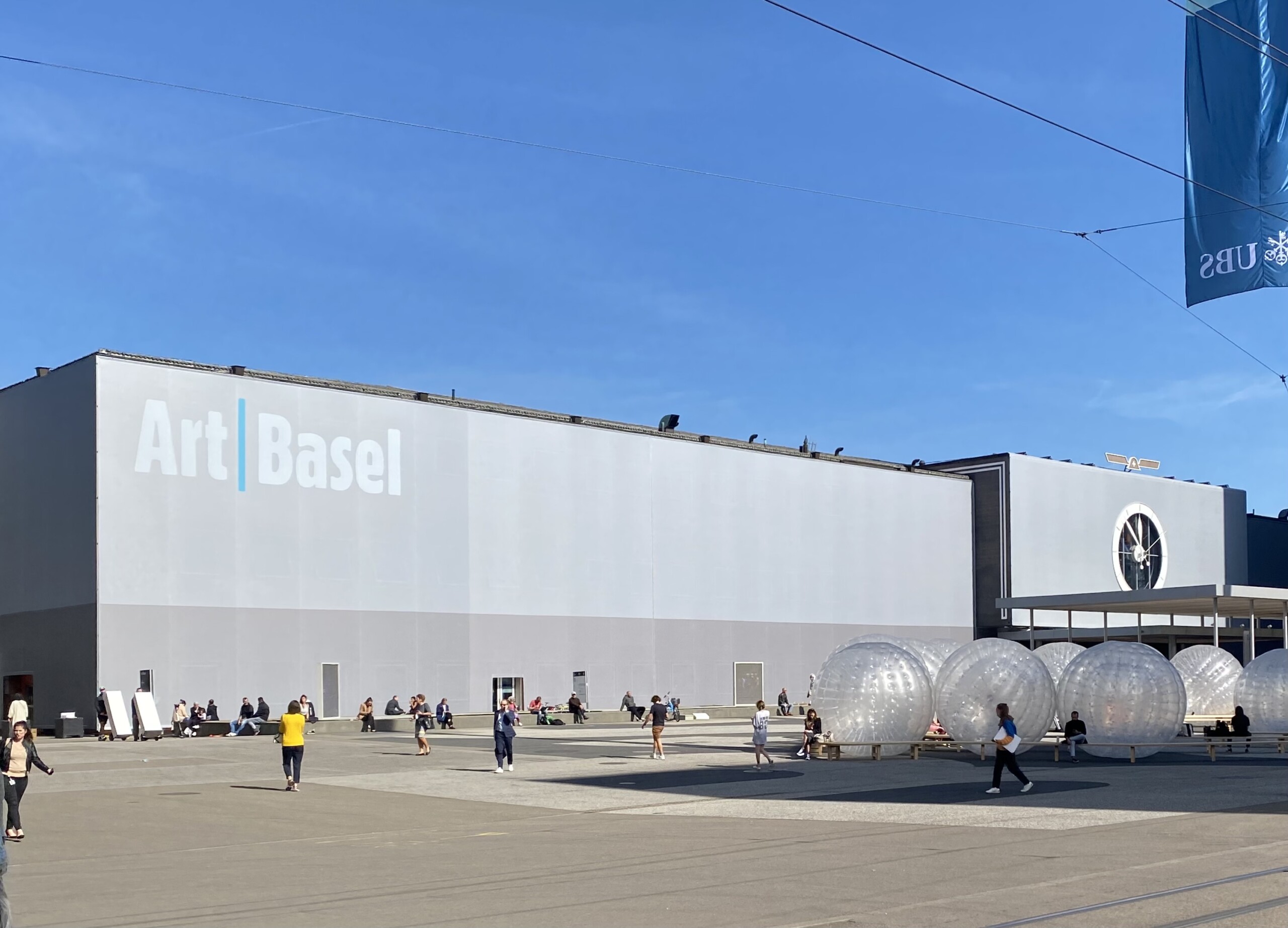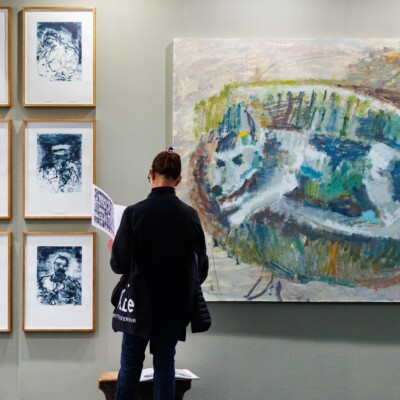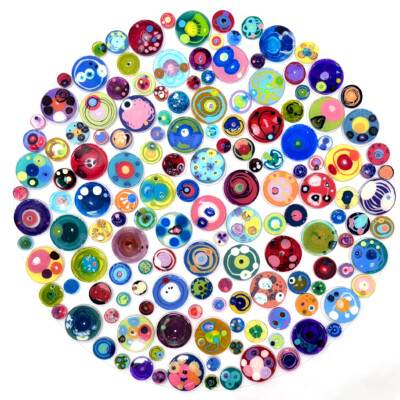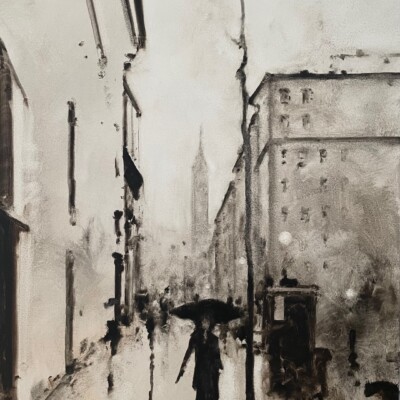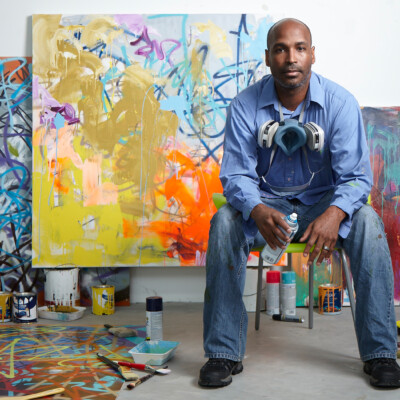AWAD is delighted to welcome our first guest blogger. Global AWAD Chapter member and founder of Art Vista Magazine, Kristen Knupp.
After a long wait it was fantastic to be back at Art Basel, seeing work in real life. After a Covid pass check in the health tent, we moved inside. Thursday, the last private day, was quiet at the main fair, as well as at Volta, but Friday saw crowds pouring into the Messe Halle at opening hour.

What were the main themes at Art Basel this year? After being locked in their studios for over a year, it seems that artists have moved towards the homemade, with craft-inspired work on display that evidenced a human touch, and textiles appearing at many galleries. Many galleries had hand-written the artwork information on the stand wall, emphasizing the humanity behind the show. The creative process has become more important, and evidence of hours spent creating pieces is often a prominent feature. The second floor galleries of the main hall in particular, were willing to take risks, focus on new themes, trends, and show more up-and-coming artists this year.

For example, Casey Kaplan gallery from New York was showing a large woven piece by Igshaan Adams, Mapping Yvonne’s Kitchen, 2021, that featured gold necklace chains woven into the fabric. This piece had an organic composition that seemed to grow naturally with green tufted areas as well as a shaggy fringe hanging from the bottom edge. It contrasted nicely with futuristic sculptures on the stand. Casey Kaplan also showed a piece that appeared to be woven linen but was in fact acrylic on canvas by Giorgio Griffa titled “Numerazione doppia”.

Sikkema Jenkins & Co. were showing Jeffrey Gibson’s beaded work with artificial sinew and acrylic on deer hides at their booth. The eye-catching brightly-coloured framed works and glass-beaded sculpture on a rustic wooden plinth are evidence of the focus on hand-crafted pieces. Even these, however, have a very professional finish and presentation.

Regen Projects from California showed a large Doug Aitken textile piece from 2020 titled “I Lost Track” that captures the zeitgeist, at least of this floor, of the fair. Made of mixed fabrics, it tells the story of the pandemic in its prose: “I lost track of information, I was blitzed by opinions, I began to see opinions arching in the air, intersecting flight patterns…”. Art produced during this time reflects the sentiments and feelings engendered by our common experience of uncertainty.

At Unlimited, this handcrafted sensibility was embodied by the first large piece encountered upon entering, Urs Fischer’s Bread House. Made from bread loaves, some of which are replaced daily and still wafting their lovely scent, stand upon cosy rugs enticing one inside. This work exemplifies Fischer’s exploration of the boundary between fantasy and reality. Is this a safe house or a dangerous one, a la the story of Hansel and Gretel? Can we relax and feel comfortable, or should we remain on guard against whatever is coming next?

In Unlimited there is also a mesmerising piece by Julius von Bismarck titled “Die Mimik Der Tethys”, 2018/2020. Inspired by Tethys, the Greek goddess of fresh water, von Bismarck hung a sea buoy in the hall, tethered by a system of pulleys and attached by satellite sensors to a real buoy in the sea. With its movements transmitted in real time by satellite, our buoy moves with the actual waves of the ocean. One feels a direct connection to the sea with this work, and all of its unpredictability, as well as the real possibility that humans may impact how it moves in the future with climate change a threat. We are here now, experiencing the sea, but what will the future bring? This is a simple, yet powerful work, and a favourite piece at Art Basel.
Van de Weghe Fine Art showed two Jean-Michel Basquiat paintings that garnered attention from passing admirers. “Hardware Store, 1983”, a yellow and turquoise diptych on stretched canvas with visible wooden supports was hung to attract interest, facing outward, while a black and white canvas was more hidden, but was still found by many.

Gray Gallery presented a stunning Helen Frankenthaler titled “Arriving in Africa from 1970, with lovely, light-filled washes of color. Mnuchin Gallery showed a delightful, small-scale Sam Gilliam watercolour, Untitled, 1970. Despite its diminutive size, it still captured the essence of Gilliam’s draped, layered watercolours, and it had sold. This was alongside an El Anatsui piece, “Plot a Plan IV” from 2007 that sparkled with its undulating waves of painted metal links.

El Anatsui, “Plot a Plan IV”, 2007. Courtesy of Mnuchin Gallery. 
Sam Gilliam, “Untitled”, 1970. Courtesy of Mnuchin Gallery. 
Helen Frankenthaler “Arriving in Africa” 1970. Courtesy of Gray Gallery.
A favourite piece from this section was a trio of Bridget Riley pencil and gouache works on graph paper, “Egyptian Stripes” shown at Hazlitt, Holland-Hibbert. Beautifully lit, these pieces are miniatures of her striped paintings, with the same color palette as her larger paintings, which was inspired by her travels to Egypt. Since they are on graph paper, however, there is an immediacy to them, and the artist’s hand is felt more powerfully than with her paintings. Two were already sold to an astute buyer.

The Volta Fair took a new angle this year, with a focus on technology and the NFT phenomena at many of the stands, even as an addition to the offer of a traditional painting. At Abigail Ogilvy Gallery, for example, Natalia Wrobel’s abstract-expressionistic paintings are accompanied by the soundtrack that inspired her, as well as poems and literature that she read while creating them.

MeetFrida gallery took technology to a new level with their artist Ju Schnee who creates painting on canvas, as well as a digitally-animated copy of the piece that is available as an NFT. They have also developed technology for a virtual reality gallery that is available by scanning a QR code into your phone. The VR gallery pops up on your phone and viewers can navigate their way through the artworks, just by moving their phone around. Although the technology was a little glitchy, the future of art shows will include more use of virtual reality, at least as an addition to real life encounters.

There are many possibilities for the future of the art world, and it is interesting to witness the different directions that galleries and artists are taking in this new, hopefully post-pandemic world. The allure of visiting artwork in person has perhaps even intensified after months without it, and we still cherish the face-to-face interactions that one finds at places like Art Basel.
All photos are credited to Kristen Knupp and taken at either Art Basel 2021 or Volta Basel 2021.
